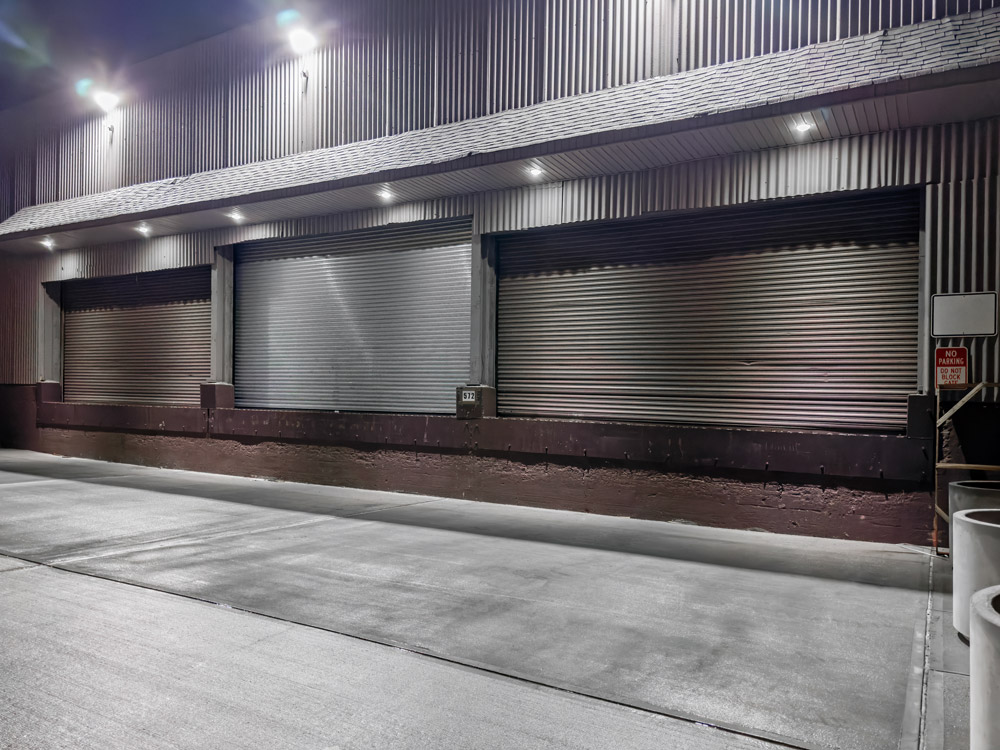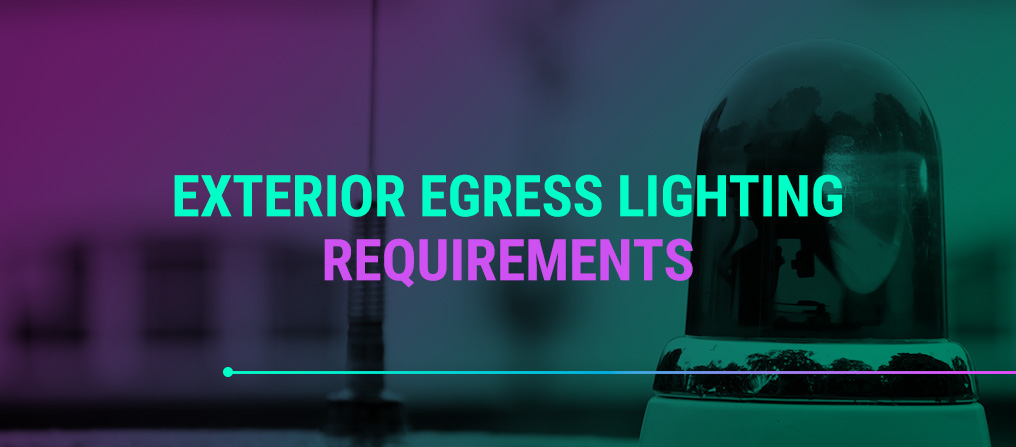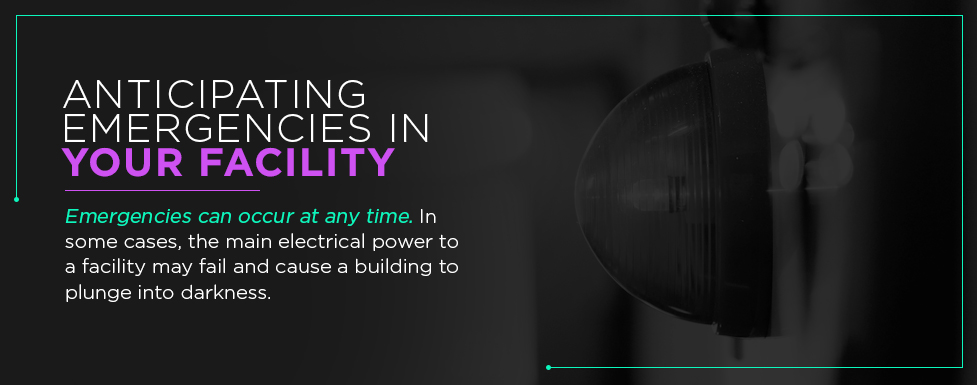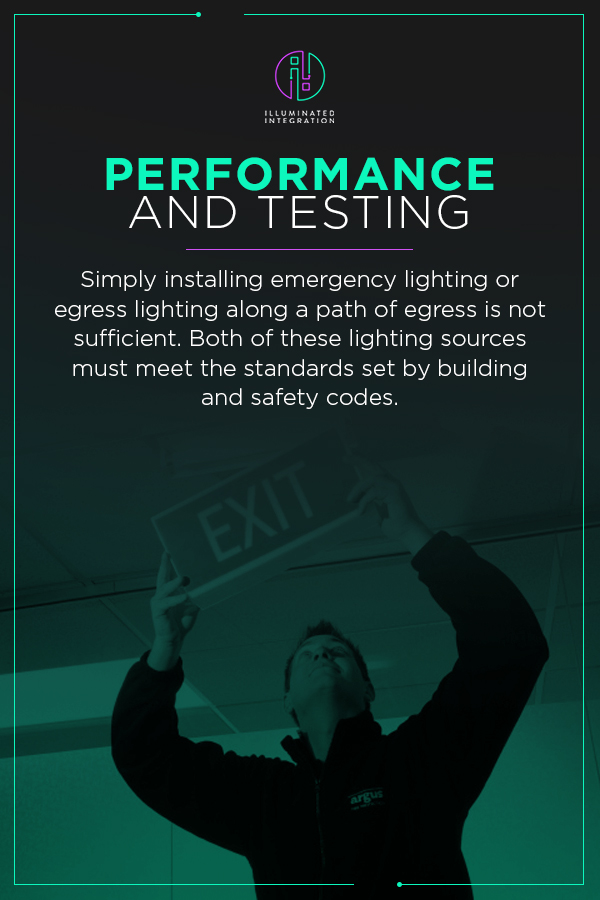

The lighting systems throughout the interior and exterior of your facility work together to create a safe, vibrant and attractive atmosphere for your employees, customers and guests. Although your facilities may never experience an emergency event, all buildings must be prepared with an accessible means of egress that features adequate emergency lighting.
Hopefully, your facility will never have to rely on its egress lighting. However, we believe that all building managers should be aware of why the exterior egress lighting requirements are in place and how they can continue to meet each life safety code applicable to their structure. The team at Illuminated Integration is here to shed light on emergency lighting and ensure that your exterior egress lighting system meets all safety standards.

Emergencies can occur at any time. In some cases, the main electrical power to a facility may fail and cause a building to plunge into darkness. In other instances, severe weather or another extraordinary event may disable elements of your primary lighting system. Every emergency event requires swift and proper attention, especially when the safety of others is jeopardized by an absence of lighting. To provide quick and accessible routes to safety, building codes require emergency exits within close proximity know as paths of egress.
A path of egress, or means of egress, is defined as a path of travel along which an individual can exit a building or structure. These pathways must be unobstructed and continuous to facilitate the swift exit of large groups of people. A path of egress must include the exit itself, a way to access the exit and a way to safely and swiftly distance one’s self away from the building or structure after exiting it. Paths of egress are commonly known as emergency escape or exit routes.
Imagine that the fire alarm sounds in your place of work — the predetermined route of exit that you’d follow is a path of egress. Of course, people may be roaming about any part of a building or structure during an emergency, which is why paths of egress are required within specific travel distances between spaces. This ensures that no matter where an individual is, they have an unobstructed and swift way to move from their location to a safe area outside of the building.
When an emergency occurs, your facility will already be designed with paths of egress readily available for people to transverse. However, simply having a designated route to travel isn’t enough. In many cases, when an emergency occurs, those within a building or structure are within areas that are not lit by natural light. Even spaces flooded with sunlight during the day can become completely dark during the night. To provide constant illumination during an emergency event, emergency lighting and egress lighting is integrated into exterior and interior lighting systems.
Emergency lighting and egress lighting are not synonymous names for the same type of lighting system. While some may refer to these or other types of lighting by different terms, it’s vital that building owners understand the difference between egress and emergency illumination — particularly as it pertains to the language used in building codes and safety regulations. These documents define both types of lighting and what features or functions each is required to possess.

Emergency lighting is activated in cases of emergency only. The scope of emergency can range from a simple power surge to the widespread loss of electricity due to a catastrophic event. These lights are often connected to a backup generator to ensure that they will turn on in the case of an incident. Emergency lights are never illuminated other than during an emergency or through monthly and annual testing.
Egress lighting, or exit lighting, is a lighting source that you’ll encounter knowingly or not. Egress lighting includes illuminated exit signs and other wayfinding devices that direct people along the path of egress of the structure or building. Unlike emergency lights, egress lighting is required to stay illuminated at all times of the day and night when a building is occupied and operational. It’s important to remember that egress lights are required in specific areas. The exit, pathway to the exit and means of egress have egress lighting.
Egress lighting is a vital resource that helps individuals access and exit a building as swiftly and safely as possible. As a responsible building owner or manager, you need to ensure that your egress lighting is installed and performing to the standards required by building and safety codes. Failure to comply with these codes could result in fines, increased costs to integrate these systems into your space. You may also be liable if someone experiences an injury on your property that may have been prevented with egress lighting.
All types of people may be in your building during an emergency or event like a fire drill. Some of these individuals may use assistive devices. Some may have health conditions, such as reduced vision or mobility issues. Having a properly lit means of egress at all times helps people of all abilities instantly identify the closest pathway to the nearest exit.
One aspect of exterior egress lighting that you must consider is that these fixtures will be exposed to the elements. Unlike interior lighting, which can often easily be integrated and protected throughout the building, exterior lighting fixtures must be able to function effectively and safely despite interference from weather. For instance, the fixtures need to operate in the rain or snow, and they must illuminate the egress areas adequately during periods of heavy precipitation or fog which may impact visibility.
When you consider updating your existing exterior egress lighting system or installing one for a new structure, you should be focused on preserving the safety of your patrons for the long-term. High-efficient lighting sources that use less energy to produce maximum illumination are ideal, especially since your egress lighting will be constantly in use. The newest technologies also include bulbs that put off less heat and produce a color temperature that provides clear visibility without being intrusive to other lighting or the eyes.
Exterior lighting can accomplish a variety of goals, chief of which is safety. You may also consider installing exterior egress lighting throughout the entire property even if it exceeds what the building codes deem as “public way” in regards to egress. Have a congruent lighting system and structure across your property will make sure that you cover all of your bases in the event that you expand your parking lots or structures. Going the extra mile to preserve safety will also be greatly appreciated by your visitors.
Exterior egress lighting is also mandatory. By implementing a system that covers all of your exterior egress lighting requirements, you fulfill your obligations to the law and to those who move about your property. Learn more about the importance of exterior egress and emergency lighting by speaking with our team of lighting industry experts. They’re familiar with the codes and standards you need to uphold as well as the best ways to integrate a dynamic system throughout your exterior.
Just as there are many different types of interior and exterior lighting, there are also different egress lighting fixtures that can be integrated into a building’s lighting system. Some fixtures, like exit signs and egress pathways signs, provide guidance to the exits or towards safe spaces outside of the building, while temporary or standby lighting fixtures can provide emergency lighting when needed.
When choosing how to provide properly lit egress pathways throughout your exterior that comply with all building codes and standards, you have many options. Thankfully, some of these lighting systems can act as functional and aesthetic enhancements when they’re not relied on for evacuations or emergencies. Contact the expert lighting designers at Illuminated Integration to discover how your architectural and exterior lighting can function as egress lighting when necessary. We’ll design a versatile, customized exterior lighting system that meets your needs and satisfies all code requirements.

Simply installing emergency lighting or egress lighting along a path of egress is not sufficient. Both of these lighting sources must meet the standards set by building and safety codes. The Life Safety Code and The International Building Code each list the requirements necessary for lighting a means of egress. These standards must be met when constructing the building and upheld as long as the building remains operational and occupied. While they are similar, the details of both must be met equally.
You may be familiar with a previous set of standards used, referred to as The Uniform Building Code (UBC). This was created to ensure that all buildings within an area follow specific construction rules to protect and preserve the lives of those within and around the structure. Regarding egress lighting, Section 1003.2.9.1 required that all buildings, when occupied, needed to have all means of egress illuminated greater than or equal to one footcandle of illumination at floor level.
The UBC was created in 1927 but was replaced in 2000. Along with the UBC, the new International Building Code replaced the BOCA National Building Code and the SBCCI Standard Building Code. The International Code Council merged these three codes into the International Building Code to ensure a consistent set of standards were used in building construction.
These are not the only codes that your building may need to meet when integrating emergency and egress lighting into your facility. Depending on the details of the most recent code or standard, your lighting systems are required to meet general performance requirements. For instance, the intensity of lighting in egress pathways must not fall below a certain level. There are some areas in which the standards don’t clearly define the illumination requirements, such as stairways. These areas are open to interpretation.
The best way to ensure that you’re staying within the guidelines of these codes is to test your egress and emergency lighting systems periodically. It is recommended that emergency lighting systems are tested monthly. Generator systems tests should be completed monthly as well, while storage-battery systems and unit equipment should be tested annually, but can be completed in conjunction with the monthly generator system tests. If you are unsure how to test your egress lighting performance, feel free to give us a call for guidance.

The safety of those visiting your facility should be your number one priority. All facilities need to have clearly illuminated paths of egress during an emergency. The lighting system design experts at Illuminated Integration want to help you meet your exterior egress lighting requirements without fail. Our team is ready to assess your building’s needs and create a customized lighting system that provides the illumination needed for those who must seek a means of egress during an emergency.
Contact us today to learn more about egress lighting and how Illuminated Integration can supply you with the emergency illumination necessary to keep everyone safe.
Updated on 2/2/2021